

Shakespeare Resource Center. Approaches to Shakespeare. Custom Search Studies in Shakespeare Critical Approaches to Shakespeare: Some Initial Observations [This document has been prepared by Ian Johnston for students of English 366 at Malaspina University-College (now Vancouver Island University).
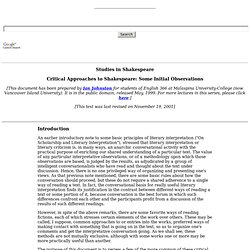
It is in the public domain, released May, 1999. For more lectures in this series, please click here.] [This text was last revised on November 19, 2001] Introduction An earlier introductory note to some basic principles of literary interpretation ("On Scholarship and Literary Interpretation"), stressed that literary interpretation or literary criticism is, in many ways, an anarchic conversational activity with the practical purpose of enriching our shared understanding of a particular text. Essays - Appreciate Shakespeare. From philosophy to literature to learning a new language, Humanities 360 is a veritable fountain of knowledge on everything you’d like to know about the humanities.
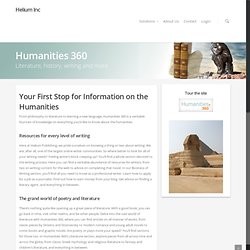
Resources for every level of writing Here at Helium Publishing, we pride ourselves on knowing a thing or two about writing. We are, after all, one of the largest online writer communities. So where better to look for all of your writing needs? Books. Thinking with Shakespeare: Essays. Rhetoric - With what persuasion . . . The Prince, Machiavelli- 1513. Back to Medieval Source Book | ORB Main Page | Links to Other Medieval Sites | Medieval Sourcebook: Nicolo Machiavelli (1469-1527): The Prince, 1513 Chapter I : How Many Kinds of Principlaities There are, and by What means they are Acquired Chapter IV : Why The Kingdom of Darius, Conquered by Alexander, Did Not Rebel Against The Successors of Alexander At His Death Chapter V : Concerning The Way To Govern Cities Or Principalities Which Lived Under Their Own Laws Before They Were Annexed Chapter VI : Concerning New Principalities Which Are Acquired by One's Own Arms And Ability.
ENGL E-129 Shakespeare After All Free online course in video lectures. Course Description : This course focuses on Shakespeares later plays beginning with Measure for Measure and ending with The Tempest.
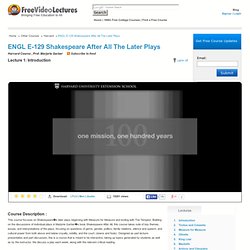
Building on the discussions of individual plays in Marjorie Garbers book Shakespeare After All, this course takes note of key themes, issues, and interpretations of the plays, focusing on questions of genre, gender, politics, family relations, silence and speech, and cultural power from both above and below (royalty, nobility, and the court; clowns and fools). Designed as part lecture-presentation and part discussion, this is a course that is meant to be interactive, taking up topics generated by students as well as by the instructor. We discuss a play each week, along with the relevant critical reading.
Other Resources : These video lectures are licensed under Creative Commons Attribution-Noncommercial-Share Alike 3.0 Unported License by Harvard University. Study Resources. Shakespeare's language. Download this document for a brief explanation of how Shakespeare's language works, together with descriptions of some of the major tools of his art.
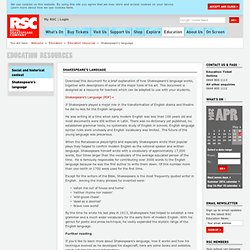
This document is designed as a resource for teachers which can be adapted to use with your students. Shakespeare's Language (PDF) » If Shakespeare played a major role in the transformation of English drama and theatre he did no less for the English language. He was writing at a time when early modern English was less than 100 years old and most documents were still written in Latin. There was no dictionary yet published, no established grammar texts, no systematic study of English in schools. When the Renaissance playwrights and especially Shakespeare wrote their popular plays they helped to confirm modern English as the national spoken and written language.
Except for the writers of the Bible, Shakespeare is the most frequently quoted writer in English. Shakespeare Illustrated. Shakespeare Illustrated, a work in progress, explores nineteenth-century paintings, criticism and productions of Shakespeare's plays and their influences on one another.

The Introduction to Shakespeare Illustrated The plays of Shakespeare are listed alphabetically. Under each play is a list of paintings based on that particular work. The artists are also listed alphabetically. Under the name of each artist is a list of paintings based on various plays by Shakespeare. The bibliography lists the works cited in Shakespeare Illustrated. iTunes U - Shakespeare Lectures. 300-level Course - Shkspr's plays. Teaching Resources: Lesson Plans. Folger Education offers a world of online resources for teachers, from individual teaching modules to curriculum guides to videos.

As a national leader in the way Shakespeare is taught in American classrooms, we believe that the best way to help students succeed is to provide teachers with the best classroom resources possible. Keep in touch with us! Sign Up for BardNotes Get the latest information on new resources, lesson plans, workshops, and other news through our free monthly e-newsletter, BardNotes , especially designed for K-12 educators. Ideas created by today's classroom teachers. Other Resources "Making a Scene" Blog for Teachers Join the conversation about best practices in teaching Shakespeare, trends in education, and information on Folger programs and activities. Glossary of Shkspr's Words. Timeline of Plays. The Chronology of Shakespeare's Plays Establishing the chronology of Shakespeare's plays is a most frustrating and difficult task.
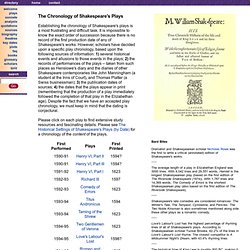
It is impossible to know the exact order of succession because there is no record of the first production date of any of Shakespeare's works. However, scholars have decided upon a specific play chronology, based upon the following sources of information: 1) several historical events and allusions to those events in the plays; 2) the records of performances of the plays -- taken from such places as Henslowe's diary and the diaries of other Shakespeare contemporaries like John Manningham (a student at the Inns of Court), and Thomas Platter (a Swiss businessman); 3) the publication dates of sources; 4) the dates that the plays appear in print (remembering that the production of a play immediately followed the completion of that play in the Elizabethan age).
Please click on each play to find extensive study resources and fascinating details. Related Articles.